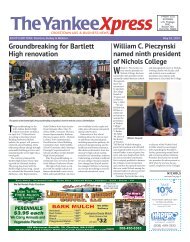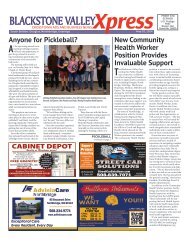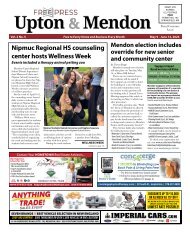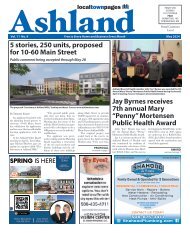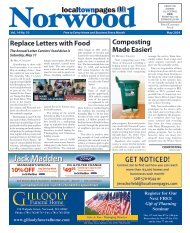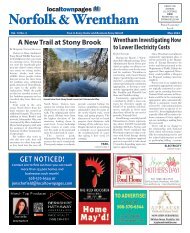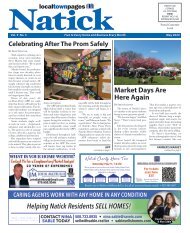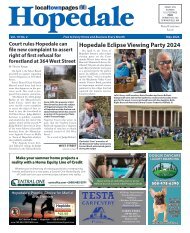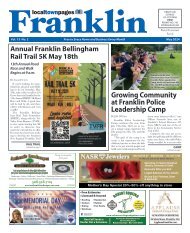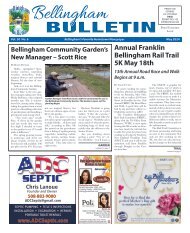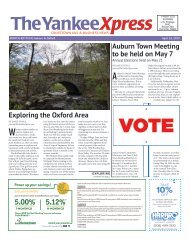Create successful ePaper yourself
Turn your PDF publications into a flip-book with our unique Google optimized e-Paper software.
April 2020 Ashland Local Town Pages www.localtownpages.com Page 15
The Problem
of Unleashed,
Unlicensed Dogs
By Cathy Rooney
In 2019, there were 1,711
licensed and at least 112 unlicensed
dogs in the town of Ashland.
That’s roughly one dog per
100 people in town, and one dog
every ½ acre! Unlicensed dogs
are also unvaccinated dogs! The
most serious vaccination that a
dog can be missing is the rabies
vaccine.
If your dog runs is bitten, for
instance, by a rabid raccoon, the
dog will contract rabies. Animals
with rabies go through two stages.
One of them is a hyper-excitable
and unpredictable stage where
they are known to turn on their
owners and bite anyone who tries
to deal with them. In this way,
the dogs pass on the disease to
people. The second stage is acute
paralysis where the dog generally
dies of respiratory failure as their
muscles become paralyzed. What
a terrible way to die!
Ashland Town Forest Committee
(ATFC) volunteers believe
the forest gets traffic of around
50-60 dogs at each entrance on
a nice day in the cold weather.
About 1/3 of the dogs are
leashed, and almost none of them
have visible dog bags. On a walk
last spring, ATFC members got
‘lots of attitude’ when we asked
dog owners to leash their dogs.
In other towns, open space committees
have resorted to banning
dogs due to dog owners refusing
to use leases and from an abundance
of trash and dog deposits.
Each dog creates ¾ pounds
of solid waste daily, which is 274
pounds of waste on an average
of a half-acre of land per year.
Added up, that’s an unsustainable
amount of waste to get dumped
into Ashland each year. And that
doesn’t include all the visiting
dogs that come to our town to
enjoy our many scenic charms!
The population of dogs is
actually more than the environment
can carry. There is an overabundance
(almost half a million
pounds created by Ashland dogs
alone) of dog deposits that is simply
unsustainable to both our
sidewalks, roadsides, parks and
our natural areas.
Dog waste contains over 7
billion bacteria, nutrients and
nitrogen that promote noxious
weeds and kills desirable plants.
Rainstorms and snowmelt move
pet waste into waterways, where
it creates algae growth. The water
turns cloudy, green, and then
brown; and it really starts to stink!
Decaying waste in our waterways
depletes the oxygen in the water
column killing fish and other organisms
that require oxygen to
breathe.
Responsibility of Dog
Ownership
Dog ownership confers responsibilities
to the owners – licensing
and vaccinating their
dogs, only bringing them where
they are allowed, leashing them
in public and cleaning up after
them. Whenever you take your
dog off your property, you should
have bags to clean up after them,
and then properly dispose of
the bag in the trash. Dog waste
thrown or left on the side of trails,
sidewalks, streams and rivers is
dog waste in the environment
with a plastic bag!
In the planned Ashland Dog
Park off the MBTA access road,
dogs will be fenced in and allowed
to run free, with separate
areas for large and small dogs. We
are imagining a park with trees,
fresh water for dogs and humans,
parking, and a couple of benches.
Anyone interested in joining our
effort to create a dog park should
email AshlandDPC@gmail.com,
or for more information, visit
Ashlanddogpark.com.
Cathy Rooney is a member of
the Town Forest and Dog Park
committees and of the Friends
of the Upper Charles River
Trail. This article was edited by
Local Town Pages writer Cynthia
Whitty.
Editor’s note: Rooney reported that
on March 9 the Conservation Commission
banned unleashed dogs from Warren
Woods.
Did You Know?
Investing in a home renovation
project not only requires
money, but also time and patience.
While contractors, architects
and designers can estimate
how long a project may take, it
is impossible to anticipate all of
the scenarios that can affect that
estimated timeline. Information
from the real estate firm Keller
Williams indicates an average
kitchen remodel involving installation
of new countertops,
cabinets, appliances, and floors
can take three to six months.
But if ductwork, plumbing or
wiring must be addressed, the
job may take longer. A midline
bathroom remodel may take two
to three months. Adding a room
to a house can take a month or
two. The home improvement
resource Renovation Junkies offers
similar estimates, with the
average home renovation taking
between four and eight months.
Homeowners need to consider
time when planning their home
projects.
Run Your Ads With Us!
Call Jen (508) 570-6544



